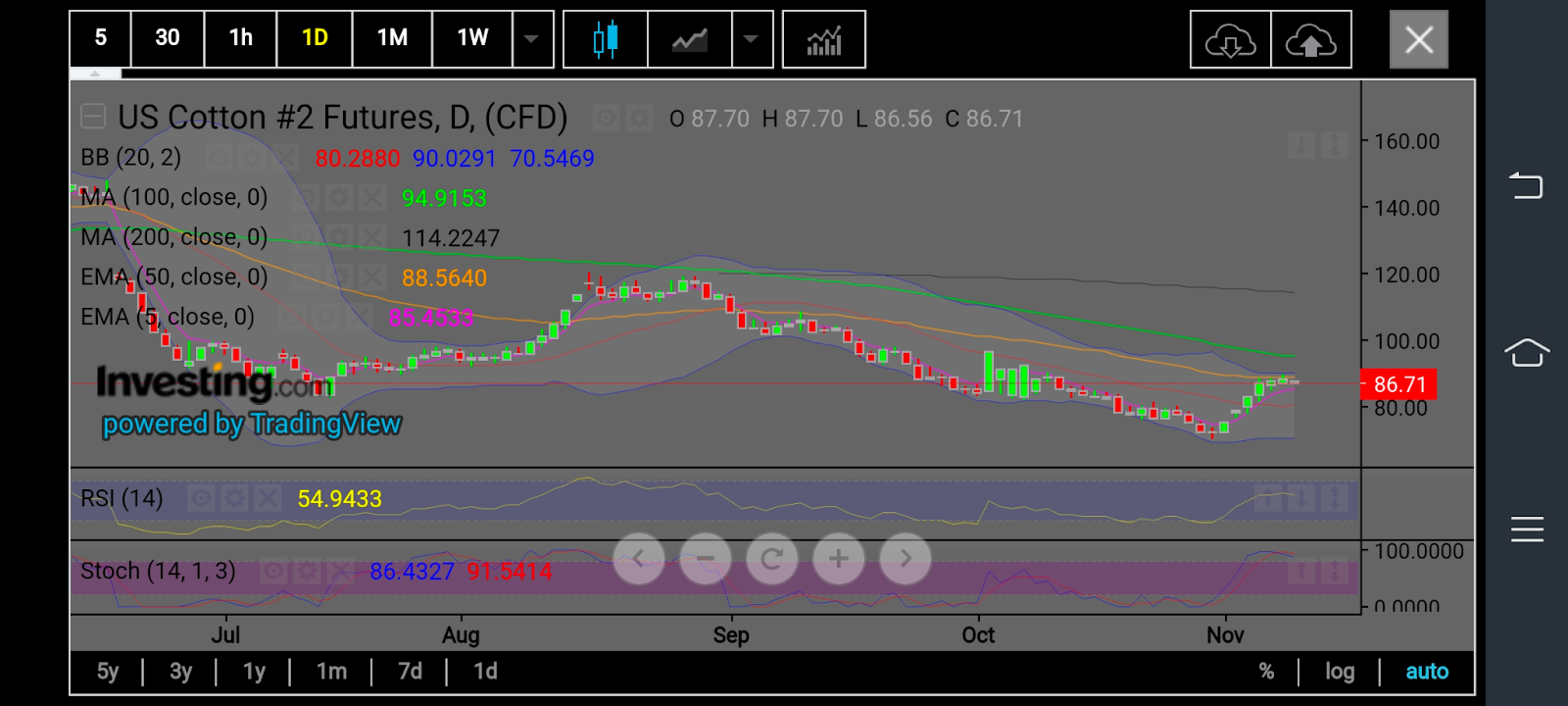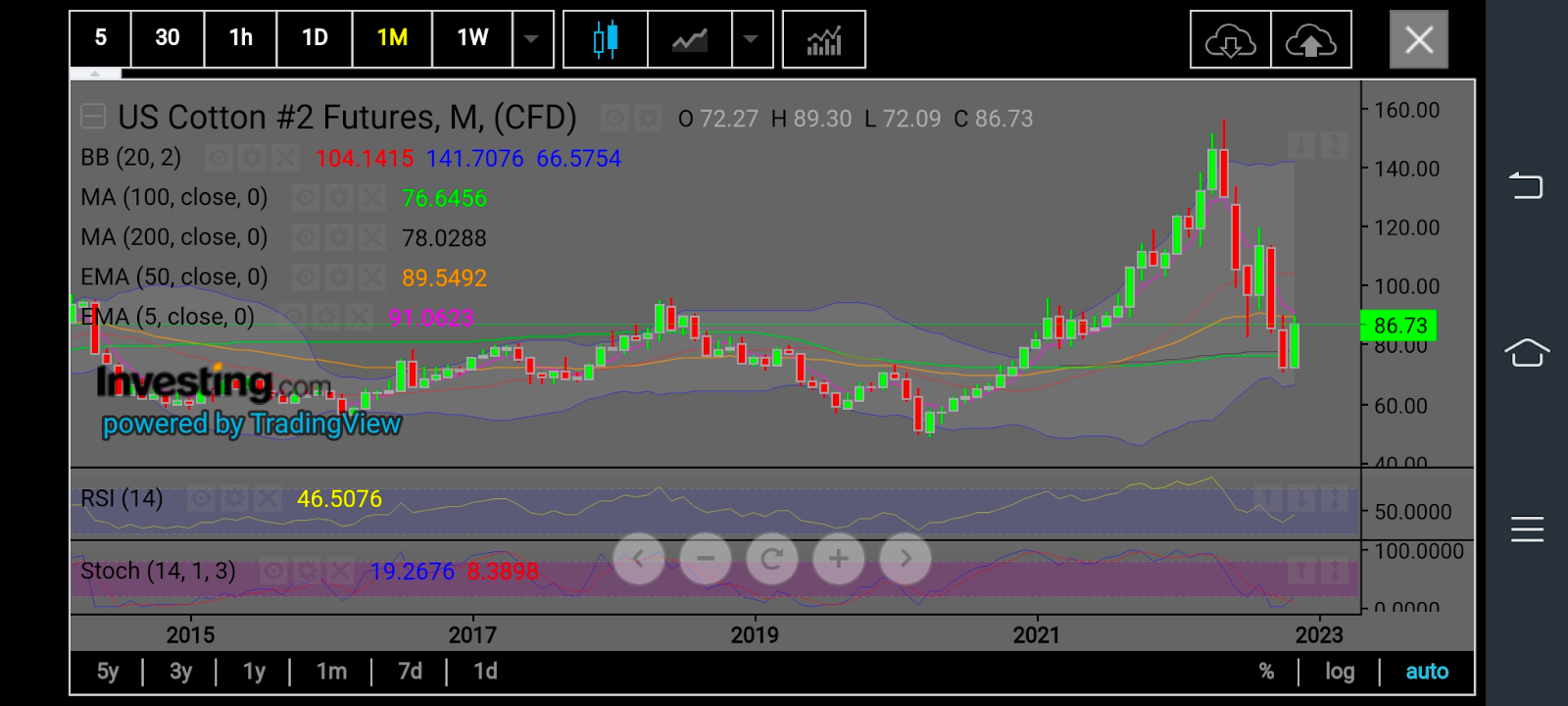- Fiber up 22% last week, the most since a 21% rally in December 2012
- Cotton oversold on recession fears; output slide adds to bullish advance
- Cotton could go to $1.07
The outlook for cotton is cautionary for the rest of 2022 after a volatile first half, the International Cotton Advisory Committee (ICAC) says in its latest price projection on the fiber.
It couldn't have been more prescient with its call.
Last week, cotton on ICE Futures US rose almost 21% for its biggest week in 12 years. Since then, it has dipped less than half a percent, signaling greater upside should the rally resume.

Charts courtesy of SKCharting.com, with data powered by Investing.com
At the close of Tuesday’s trade, the front-month in the so-called ICE cotton settled just shy of 87 cents an lb, after hitting a five-week high of 89.30 cents. Last week’s 21% rally came in a touch below the 22% gain seen during the week to Dec. 3, 2010.
The ICAC said jittery speculators and investment firms concerned about a global recession had driven cotton prices down from early May to mid-June, then again in September through October, when the market hit its lowest since.
Production-wise, drought has also prompted farmers to abandon virtually all non-irrigated cotton, the ICAC noted. It said the deficit could be mitigated by good crops in other cotton-producing countries, although there’s no guarantee that will happen.
“This is an especially dangerous development because we don’t need to go into a global recession to cause problems. Fear that we might go into a recession is sufficient to wreak havoc in cotton markets. Buckle yourself in because 2022-23 looks like it’s going to be a bumpy ride. As we open the 2022-23 season, the cotton market is looking at a very uncertain future over the next few months.”
The Sourcing Journal, in a Nov. 1 focus on cotton, said a quarterly report from CoBank’s Knowledge Exchange concurred with the ICAC’s findings, noting that fears that the rapidly decelerating global economy stifled cotton demand have led December 2022 cotton futures to plummet 35% from their mid-May highs. However, CoBank economists believe the fears of plunging cotton demand may be overblown.
The latest USDA report featured decreases in global production and mill-use forecasts for 2022-23. The current projection calls for 82.8 million bales of ending stocks in 2022-23—the lowest volume since 2018-19, when global ending stocks were 81.5 million bales and the A Index averaged 84 cents per pound.
The US forecast plummeted 2.9 million bales to 12.6 million.
Cotton Incorporated senior economist Jon Devine said in his August “Economic Letter,” also cited by The Sourcing Journal, that if the USDA forecast is realized, this would be the smallest US crop since 2009-10. With this reduction, the United States drops to the fourth position in the rankings of the world’s largest cotton producers behind China, India and Brazil.
Notwithstanding the production cut, the US still ranks as the world’s largest cotton exporters, with 12 million bales forecast ahead of Brazil’s expected exports of 9.3 million bales in 2022-23.
“Cotton prices continue to be caught between the two competing storylines that have been in play for the past several months,” Devine said.
“On one side, there is the deteriorating global macroeconomic situation. The International Monetary Fund (IMF) lowered its projection for global economic growth in both 2022 (3.2%) and 2023 (2.9 %) in the updates released in late July. Current IMF forecasts are significantly beneath those from January and April.”
Devine adds that the evolution in the macroeconomy was a likely factor contributing to the shift in investors’ outlook on the commodity sector, which led to a collapse in prices for cotton and a range of other commodities in June and July. There also could be factors associated with cotton supply chains that could affect demand during the current crop year.
“Downstream consumer markets for cotton can be viewed as more discretionary than other spending categories such as food, energy and lodging that experienced some of the sharpest effects of inflation,” Devine said.
“Given price increases for necessities, consumers may have less income to devote to apparel and home furnishings.”
Tight US supply is on the other side of price direction arguments, he noted. Cotton is drought tolerant and that is why it can be viably grown in perennially dry locations like West Texas. However, cotton requires some moisture to germinate and generate healthy yields and West Texas has had little rain over the past year and drought conditions have been extreme.
As a result, abandonment is forecast to be widespread. It remains to be seen exactly how small the US crop will be, but the current USDA forecast predicts only 12.6 million bales in 2022-23, 5 million fewer bales than in 2021-22, Devine noted.
“Meanwhile, demand for US cotton has been relatively consistent, near 18 million bales over the past five crop years,” Devine said.
“A harvest of only 12.6 million falls well short of the recent average for exports alone and U.S. stocks were near multi-decade lows coming into 2022-23. All these statistics suggest shipments from the world’s largest exporter may have to be rationed in 2022-23.”
“If cotton is not readily available from other sources, the scarcity of supply from the U.S. could support prices globally,” Devine added.
“Simultaneously, there is weakness from the demand side. The market has struggled to find the balance between the weakened demand environment and limited exportable supply in recent months. The conflict between these two influences makes it difficult to discern a clear direction for prices and suggests continued volatility.”
So, where could cotton futures go from here? If the rally resumes at last week’s pace, cotton’s charts indicate that the fiber could get to $1.07 an lb, reprising highs from late August, said Sunil Kumar Dixit, chief technical strategist at SKCharting.com.

Dixit bases his projections on ICE cotton’s front-month December contract, which he said signals adequate strength for a sustained break above the confluence of the 50-month Exponential Moving Average (EMA) of 89.55 cents and the five-month EMA of 91.08 cents.
“Cotton has turned into a smoking hot commodity, as I see it,” said Dixit.
“Decisive consolidation above this zone can trigger a strong upward move towards the monthly middle Bollinger Band of $1.04.”
Most key technical indicators for cotton were also in the positive, including the monthly stochastics which were in overlap, while the Relative Strength Index points upward.

The midterm outlook on cotton’s weekly time frame also indicates bullish targets beginning with the weekly middle Bollinger Band of 98.50 cents, then the 100-week Simple Moving Average (SMA) of 103.60 and eventually the 50-week Exponential Moving Average (EMA) of 106.80.
But like all markets, cotton also had its vulnerabilities, said Dixit, adding:
“On the flip side, rejection from the 200-week SMA of 84.45 may begin to weigh on rebound attempts, pushing prices down to previous week's low of 70.21.”
Disclaimer: Barani Krishnan uses a range of views outside his own to bring diversity to his analysis of any market. For neutrality, he sometimes presents contrarian views and market variables. He does not hold a position in the commodities and securities he writes about.
